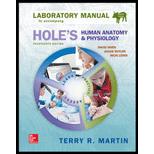
Laboratory Manual for Holes Human Anatomy & Physiology Fetal Pig Version
14th Edition
ISBN: 9781259295645
Author: Terry R. Martin
Publisher: McGraw-Hill Education
expand_more
expand_more
format_list_bulleted
Concept explainers
Question
Chapter 20, Problem 3.2CT
Summary Introduction
To analyze:
The muscle of facial expression in the given figure.
Introduction:
The facial muscles are different from other muscles in the organization as these muscles do not have deep membranous fascia near facial skin. These muscles are directly inserted into the skin. These muscles are present around scalp like occipitofrontalis, around eyelid like orbicularis oculi muscle, in the auricle, in the nose like procerus muscle, in the neck like platysma muscle, and around the mouth.
Expert Solution & Answer
Want to see the full answer?
Check out a sample textbook solution
Students have asked these similar questions
Diagram of check cell under low power and high power
a couple in which the father has the a blood type and the mother has the o blood type produce an offspring with the o blood type, how does this happen? how could two functionally O parents produce an offspring that has the a blood type?
What is the opening indicated by the pointer? (leaf x.s.)
stomate
guard cell
lenticel
intercellular space
none of these
Chapter 20 Solutions
Laboratory Manual for Holes Human Anatomy & Physiology Fetal Pig Version
Ch. 20 - Prob. F20.1ACh. 20 - Prob. F20.2ACh. 20 - Prob. 1.1ACh. 20 - Prob. 1.2ACh. 20 - Prob. 1.3ACh. 20 - Prob. 1.4ACh. 20 - Prob. 1.5ACh. 20 - Prob. 1.6ACh. 20 - Prob. 1.7ACh. 20 - Prob. 1.8A
Ch. 20 - Complete the following statements: The can flex...Ch. 20 - Prob. 1.10ACh. 20 - Prob. 1.11ACh. 20 - Complete the following statements: The muscle used...Ch. 20 - Complete the following statements: When the...Ch. 20 - Complete the following statements: The...Ch. 20 - Complete the following statements: The...Ch. 20 - Complete the following statements: The temporalis...Ch. 20 - Complete the following statements: The...Ch. 20 - Complete the following statements: The...Ch. 20 - Complete the following statements: The...Ch. 20 - Complete the following statements: The...Ch. 20 - Complete the following statements: The...Ch. 20 - Identify the muscles of various facial expressions...Ch. 20 - Prob. 3.2CTCh. 20 - Prob. 3.3CTCh. 20 - Prob. 3.4CTCh. 20 - Prob. 3.5CT
Knowledge Booster
Learn more about
Need a deep-dive on the concept behind this application? Look no further. Learn more about this topic, biology and related others by exploring similar questions and additional content below.Similar questions
- Identify the indicated tissue? (stem x.s.) parenchyma collenchyma sclerenchyma ○ xylem ○ phloem none of thesearrow_forwardWhere did this structure originate from? (Salix branch root) epidermis cortex endodermis pericycle vascular cylinderarrow_forwardIdentify the indicated tissue. (Tilia stem x.s.) parenchyma collenchyma sclerenchyma xylem phloem none of thesearrow_forward
- Identify the indicated structure. (Cucurbita stem l.s.) pit lenticel stomate tendril none of thesearrow_forwardIdentify the specific cell? (Zebrina leaf peel) vessel element sieve element companion cell tracheid guard cell subsidiary cell none of thesearrow_forwardWhat type of cells flank the opening on either side? (leaf x.s.) vessel elements sieve elements companion cells tracheids guard cells none of thesearrow_forward
- What specific cell is indicated. (Cucurbita stem I.s.) vessel element sieve element O companion cell tracheid guard cell none of thesearrow_forwardWhat specific cell is indicated? (Aristolochia stem x.s.) vessel element sieve element ○ companion cell O O O O O tracheid O guard cell none of thesearrow_forwardIdentify the tissue. parenchyma collenchyma sclerenchyma ○ xylem O phloem O none of thesearrow_forward
- Please answer q3arrow_forwardRespond to the following in a minimum of 175 words: How might CRISPR-Cas 9 be used in research or, eventually, therapeutically in patients? What are some potential ethical issues associated with using this technology? Do the advantages of using this technology outweigh the disadvantages (or vice versa)? Explain your position.arrow_forwardYou are studying the effect of directional selection on body height in three populations (graphs a, b, and c below). (a) What is the selection differential? Show your calculation. (2 pts) (b) Which population has the highest narrow sense heritability for height? Explain your answer. (2 pts) (c) If you examined the offspring in the next generation in each population, which population would have the highest mean height? Why? (2 pts) (a) Midoffspring height (average height of offspring) Short Short Short Short (c) Short (b) Short Tall Short Tall Short Short Tall Midparent height (average height of Mean of population = 65 inches Mean of breading parents = 70 inches Mean of population = 65 inches Mean of breading parents = 70 inches Mean of population = 65 inches Mean of breading parents = 70 inchesarrow_forward
arrow_back_ios
SEE MORE QUESTIONS
arrow_forward_ios
Recommended textbooks for you
 Fundamentals of Sectional Anatomy: An Imaging App...BiologyISBN:9781133960867Author:Denise L. LazoPublisher:Cengage Learning
Fundamentals of Sectional Anatomy: An Imaging App...BiologyISBN:9781133960867Author:Denise L. LazoPublisher:Cengage Learning Medical Terminology for Health Professions, Spira...Health & NutritionISBN:9781305634350Author:Ann Ehrlich, Carol L. Schroeder, Laura Ehrlich, Katrina A. SchroederPublisher:Cengage Learning
Medical Terminology for Health Professions, Spira...Health & NutritionISBN:9781305634350Author:Ann Ehrlich, Carol L. Schroeder, Laura Ehrlich, Katrina A. SchroederPublisher:Cengage Learning

Fundamentals of Sectional Anatomy: An Imaging App...
Biology
ISBN:9781133960867
Author:Denise L. Lazo
Publisher:Cengage Learning

Medical Terminology for Health Professions, Spira...
Health & Nutrition
ISBN:9781305634350
Author:Ann Ehrlich, Carol L. Schroeder, Laura Ehrlich, Katrina A. Schroeder
Publisher:Cengage Learning




Chapter 7 - Human Movement Science; Author: Dr. Jeff Williams;https://www.youtube.com/watch?v=LlqElkn4PA4;License: Standard youtube license